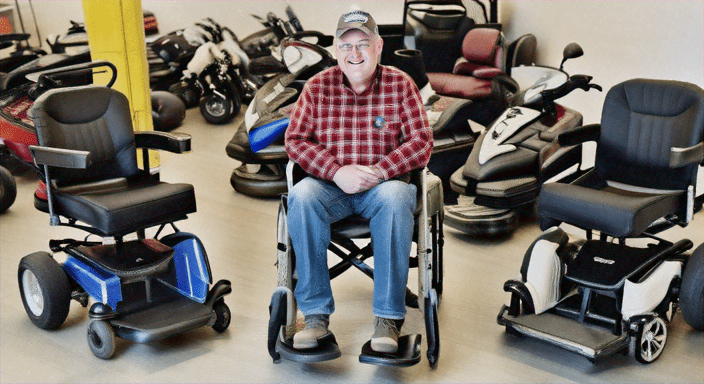The utilization of power wheelchairs can greatly enhance the freedom and independence of individuals facing mobility challenges. Despite the high cost associated with these devices, Medicare offers coverage under specific circumstances. This article delves into the Medicare benefits and coverage for power wheelchairs, elucidating the eligibility requirements, application procedures, and the various types of wheelchairs that are covered.

1. Unraveling Medicare Coverage for Power Wheelchairs
Under Medicare Part B (Medical Insurance), power-operated vehicles (scooters) and wheelchairs are categorized as durable medical equipment (DME) and are covered if deemed medically necessary. Consequently, Medicare will assist in covering the expenses for a power wheelchair if a physician or healthcare provider prescribes it for home use.
Eligibility Criteria
To be eligible for Medicare coverage of a power wheelchair, the following prerequisites must be fulfilled:
-
The individual must suffer from a health condition that significantly impedes their ability to move around within the home.
-
The individual must be incapable of performing daily activities, even with the assistance of a cane, crutch, or walker.
-
A face-to-face examination by a physician is mandatory, along with a written prescription for the power wheelchair.
-
The power wheelchair must be essential for the individual to navigate their home and carry out daily activities.
-
The individual must be capable of safely operating the wheelchair, or there must be a caregiver who is both willing and able to operate it on their behalf.
2. Varieties of Power Wheelchairs Covered by Medicare
Medicare provides coverage for various types of power wheelchairs, tailored to the unique needs of the patient. These categories include:
-
Group 1 Power Wheelchairs: Fundamental power wheelchairs designed for patients requiring a wheelchair mainly for home use.
-
Group 2 Power Wheelchairs: Equipped with more sophisticated features, these are intended for patients with more pronounced mobility impairments.
-
Group 3 Power Wheelchairs: These are intricate rehab power wheelchairs crafted for patients with severe disabilities and advanced clinical requirements.
3. The Application Procedure
Securing a power wheelchair via Medicare entails several procedural steps:
-
Face-to-Face Examination: The patient must undergo a face-to-face examination with a doctor or healthcare provider to ascertain the medical necessity of the power wheelchair.
-
Prescription: Should the doctor deem a power wheelchair necessary, they will furnish a written prescription.
-
Supplier Selection: The patient must opt for a Medicare-enrolled supplier to provide the power wheelchair. Ensuring that the supplier accepts Medicare assignment is crucial to circumvent additional costs.
-
Documentation: The doctor and the supplier will collaborate to submit the requisite documentation to Medicare for approval.
-
Approval and Delivery: Upon Medicare’s approval of the request, the supplier will deliver the power wheelchair to the patient’s residence.
4. Expenses and Financial Aid
Although Medicare shoulders a substantial portion of the expenses for a power wheelchair, patients may still incur certain out-of-pocket costs:
-
Medicare Part B Deductible: Patients are required to meet the annual Part B deductible before Medicare commences payment of its share.
-
Coinsurance: Post the deductible being met, patients generally pay 20% of the Medicare-approved amount for the wheelchair.
For those finding these costs onerous, supplementary financial assistance might be obtainable through programs like Medicaid, state assistance initiatives, or non-profit organizations devoted to aiding individuals with disabilities.
5. Upkeep and Repairs
Medicare also extends coverage to necessary maintenance and repairs for power wheelchairs to guarantee they remain in optimal working condition. This encompasses:
-
Routine Maintenance: Regular inspections and minor repairs to sustain the wheelchair’s functionality.
-
Major Repairs: Coverage for more substantial repairs if the wheelchair malfunctions or becomes inoperable due to wear and tear.
It is imperative for patients to utilize Medicare-approved suppliers for maintenance and repairs to secure coverage.
6. Supplementary Resources
A plethora of resources is at the disposal of patients to facilitate the process of acquiring a power wheelchair through Medicare:
-
Medicare.gov: The official Medicare website proffers comprehensive information on coverage, eligibility, and the application process.
-
Medicare Hotline: Patients can dial 1-800-MEDICARE for assistance and information pertaining to Medicare benefits.
-
Local Area Agencies on Aging: These agencies proffer support and resources for seniors, including aid with comprehending Medicare benefits.
Conclusion
Power wheelchairs can markedly elevate the quality of life for individuals grappling with mobility impediments. Through Medicare Part B, eligible patients can avail coverage for power wheelchairs, ensuring they have access to the mobility aids they necessitate. By grasping the eligibility criteria, types of wheelchairs covered, and the application process, patients and caregivers can adeptly navigate Medicare’s coverage and procure the requisite equipment to augment their independence and daily living.





